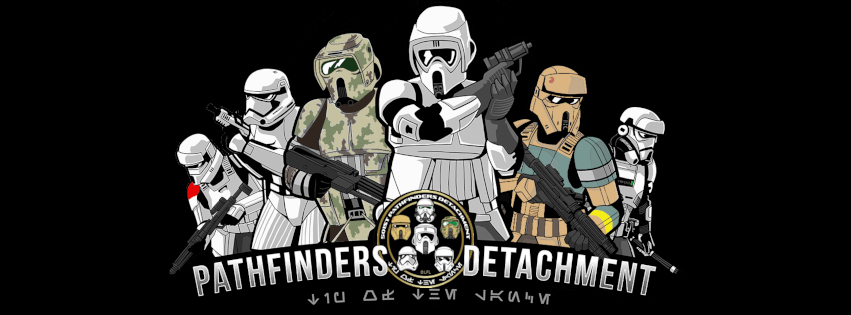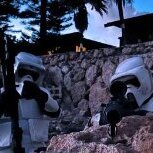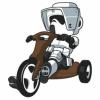
fragarock
501st Pathfinder-
Posts
67 -
Joined
-
Last visited
-
Days Won
2
fragarock last won the day on June 1 2023
fragarock had the most liked content!
Reputation
41 ExcellentAbout fragarock

Profile Information
-
Level II Badge
Lancer TB
-
Gender
Male
-
Location
Detroit
501st Information
-
Name
Frank
-
501st Designation
92111
-
501st Garrison
Great Lakes Garrison
-
501st Profile Page
http://www.501st.com/members/displaymemberdetails.php?userID=24440
Recent Profile Visitors
-
Fragarock's Scout Build
fragarock replied to fragarock's topic in Scout Trooper: "The Mandalorian" WIP
Thank you. I was really trying to match the screen look but with a different technique than others have used and one that I’m more familiar with from my shoretrooper build. Sent from my iPhone using Tapatalk -
Thanks Guys. I'm super stoked about this!
-
To get the armor kicked off I got a Creality CR-10S which has a print bed of 300x300x300mm or about 12x12x12". This was big enough to print the largest piece of the helmet. Took a bit of tinkering to get the thing figured out but after months of messing with it I threw away the print bed that came in the box and replaced it with a 12x12 mirror from Home Depot. I use Sticky Bedz adhesive spray which I leave on the print bed for multiple prints before cleaning it off with 91% isopropyl rubbing alcohol in a spray bottle. First thing to print as the helmet. Files are from Nico Henderson and they are excellent. Typically I printed with 4 walls and about 35% infill and a 0.15mm layer height. The snout which has much finer detail was printed with a lower layer height and a much slower speed. Printed in ABS. Here the print file setups so you can see how they fit on the print bed and their orientation. BP1. Outer blast plate took 27 hours. BP2 Faceplate. Printed at an angle so that it was mostly vertical, reducing the need for supports. Neck ring. This was the first really big part printed which took about 1.5 days. No supports needed other than what's shown in blue. Had to print this twice. Learned a hard lesson when priming this piece and left it in direct sunlight for too long. When I went back to check on it, the heat had softened and warped the piece so it had to go in the trash. Vents printed at about 0.5mm layer height. Snout. First time I printed this I had it flat on the print bed but didn't like the final look of the layers which came out quite visible despite being a low height and would be difficult to sand. So after a couple tries I determined tilting it at a slight angle produced better results on the top (front) of the piece. Base. This took about 6 days to print. Note that no internal supports are needed to support the top of the dome. I didn't believe it until it finished but I've printed this twice and not needed internal supports other than what is shown in blue. Here are a few shots of the printed pieces. Note that the first time I printed the face I printed both versions, one with eye bags and one without. Down the road I had to break out and replace the piece in the helmet with the non-eye bag version to fit the lens which Paul Prentice made. Here's the helmet during sanding process. Sanding was 80, 100, 200, 400 grit followed by filler primer. Then wet sanded the filler primer with 150, 200, 400 grit. Low spots in the print which couldn't be filled with primer were filled with Bondo glazing putty.
-
For my E-22 rifle I went with a 3D printed version from Eelco who has a print shop https://www.3d-props.com/. At the time he was printing and assembling his kits and you could even order a completely built/painted rifle. I don't think he does that anymore, only offerinf 3D files which appear to be similar to the ones I got years ago. He also has great photos of the blasters in their finished form. I recently got his files for a scout blaster and they were great. If you order 3D files you'll likely need to get the mounting screws and aluminum pipes which run through the rifle for support. This was the first 3D printed thing I ever had, so it was a learning curve figuring out how to finish it. The final work wasn't as good or refined as my 3D printed armor would be much later on but it was acceptable for the time and once painted black the imperfections didn't matter too much. Here are the individual pieces as I started sorting them, figuring out how it went together. First step to finishing the rough prints was to sand each piece with sandpaper in finer and finer grits. 80, 100, 200, 400. Once sanded I primed the pieces with gray automotive filler primer which you can usually find at auto parts stores. Sand the primed pieces with 100, 200 and 400 grit but this time wet sanding to get the smoothes finish possible. Any larger holes in the print were filled with bondo and sanded before the primer. Once parts were smooth, they were assembled. Some pieces like the counter and scope were made up of smaller parts so it was easier to assemble these before the final black primer. Other parts were bigger and were final primed individually. Here's the final black primer over the rifle. Here's the counter before assembly. Once I had a few good coats of primer on this I then painted it in a semi-gloss black paint. Then I rub in a coating of powdered graphite which gives a nice gun metal look. Then a clearcoat of spray can sealer to seal in the graphite. To add metallic highlights and barrel weathering I used AK TrueMetal wax paints. These are metallic based paints which come in a tube and are applied usually with a dry-brush technique which allows for very light application of the paint. If you want more paint on the blaster just lightly brush on more. Can also rub it on with a rag or paper towel. These are available at hobbie stores or Amazon. You can find videos online showing how to apply them. Primarily use aluminum, steel and brass colors. The piece below is the mount where the tactical scope attaches. Scope sold separately. The front of the barrels had 3D printed faux bolts. I replaced these with real ones from the local hardware store. I typically do this on my blasters. Cut or drill out the faux bolt and E6000 glue in the new one. With the scope I like to make it a bit more realistic by adding real lenses. You'll have to drill or cut out the interior guts of the scope on the large end to make this work. The lenses are harvested from monocular scope which you can find on Amazon pretty cheaply. Broke it apart to get the pieces I needed. The outer retainment rings are from Bulldog44 a 501st member who makes blaster scopes/parts. The monocular is a 8x20 type for about $8. Ended up gluing the larger lens and housing into an inner part from the monocular scope so it would fit better within the large cavity of the scope. Actually filled that cavity with play-doh first as a means to hold it in place. Added real screws to the scope. Then gave it a bit of brass color from the AK wax paints. Another component is the tactical light mounted to the side of the E-22. This is a real light which I got from a company called Surefire. It was there M300C scout light. Brace yourself because it's pricy. Current version is about $360. This comes with a mounting clasp allowing it to be attached to he side of the blaster. The 3D files may have a printable version of this now, not sure though. This is what it looked like out of the box. I took sandpaper to it to roughen up the edges a bit. Another needed item is a tactical rifle sling, get the kind with swivel ends which screw into the 3D printed pieces (I also glued them). Here's the final product.
-
Hi Guys, Back in 2019 & 2020 I may have been the first person to build a Mr. Paul's 3D printed kit and had a lot of help directly from Paul as I went through the process. At that time most of the ST communication was occurring on the Shoretrooper Family Facebook page so that's where I documented my build. I'm going to recreate that build here for folks to reference as they complete their own kits. So, keep in mind this work is already done, ask questions as usual and hopefully this will be useful for future troopers. You can also go onto the Facebook page and search Frank Fraga to find the build pages there. First thing I did was order a helmet kit from Jim Tripon. That is a fiberglass kit and was a nice helmet but ultimately I decided to replace it with a screen accurate version when Nico Henderson published his 3D print files about a year later. Early on I acquired the Yugoslavian ammo pouch on Ebay and got some really good boots (not Orca Bay) on Amazon. The color of the boots was a bit off, too tan and also too clean. So I darkened them with brown shoe polish and let them dry for a couple days then kicked them around my backyard and driveway to ding them up. In this early stage I wasn't sure which ST variant I was going to build so I got the basic colors for each at my local art store which sells the correct graffiti paint by Montana Gold.
-
Fragarock's Scout Build
fragarock replied to fragarock's topic in Scout Trooper: "The Mandalorian" WIP
Hi Troopers, After fixing the missing gray color on my drop boxes and removing the vertical tabs from the "T" greeblies my kit got approved! I have approval from the GML, just needs to be plugged into the system and transmitted to the appropriate parties within the 501st. Thanks to all of you who chimed in when I had questions and to those others who had really great build threads to reference. I've already replaced the dog bone leather covers on my boots with ones that extend down to the sole. Hope to submit for Level 2 approval soon. -
Fragarock's Scout Build
fragarock replied to fragarock's topic in Scout Trooper: "The Mandalorian" WIP
I went ahead and fixed the strapping at the front of the belt where the drop boxes connect. I figured it was easy enough to do and seemed to be a pretty glaring goof on my part. I'm gonna remove the old stitching to clean it up a bit too. I'm also going to nip off those tabs on the "T" greeblie on the biceps. They seemed so perfectly formed I figured they must be there on purpose. Perhaps they're part of the casting process RS uses. One of them is broken off anyways. I do see them on other RS kits that were approved though. Edit - RS confirmed those vertical tabs are on the original "found part" used to make this piece and they were removed for the film. I also fixed the recess panel on the drop boxes which I forgot to paint gray. -
Fragarock's Scout Build
fragarock replied to fragarock's topic in Scout Trooper: "The Mandalorian" WIP
Whoa, I didn't realize that little detail. If its a problem I can fix it relatively easily. It is nice having them function, a little easier to position the cummerbund. Sent from my SM-G960U using Tapatalk -
Fragarock's Scout Build
fragarock replied to fragarock's topic in Scout Trooper: "The Mandalorian" WIP
Hi, I just submitted my photos for approval. Put the whole kit on 3 separate times today so I'm getting faster but man getting that side elastic on the chest fastened up is hard. Also need a better way to secure the pouches, they are way too easy to remove, it takes some effort but they could still get ripped off during a troop. Here are some of the final photos showing weathering on the other pieces. Thanks for watching! -
Fragarock's Scout Build
fragarock replied to fragarock's topic in Scout Trooper: "The Mandalorian" WIP
Ya, its the US equivalent. Sent from my SM-G960U using Tapatalk -
Fragarock's Scout Build
fragarock replied to fragarock's topic in Scout Trooper: "The Mandalorian" WIP
It's called Movie Paint dirt spray. I haven't found it locally here in Michigan so I've ordered it. There are several L.A. based movie supply places that carry it. One if called FilmTools. Sent from my SM-G960U using Tapatalk -
David Remnant Scout Build
fragarock replied to Ghost40's topic in Scout Trooper: "The Mandalorian" WIP
Congratulations Sent from my SM-G960U using Tapatalk -
This is great. Congratulations on your great kit. Sent from my SM-G960U using Tapatalk
-
Fragarock's Scout Build
fragarock replied to fragarock's topic in Scout Trooper: "The Mandalorian" WIP
So, guess I'm nearing the end of this build. Last thing to do is to weather my cummerbund. Here goes! Started off by dying it with earl gray tea. used 3 tea bags and submerged the whole thing for a couple minutes. Surprisingly it changed the color a lot in that short amount of time. Once dry I added weathering detail to the stitching areas at the front and on the cod piece. These areas didn't naturally darken from the tea. This detail was created using oil paints mixed with Naptha and applied with a small brush. Get the brush very wet and let the color soak in along the seam. I used a mixture of white with a bit of raw umber. The idea is to make a very light beige mix that is very diluted. I applied this in layers, building it up. Then I made a new batch of burnt umber which has more red in it, again pretty diluted, to add color variation and more dirt effect. Added some droplets by flicking water/paint off the brush onto the cloth. In addition to the seams I added color to edges of the cummerbund and along the top where you can imagine sweat would build up and along the top of the pouches. Similar approach was used on the pouches, figuring a lot of dirt would collect at the top and bottom. Make sure the weathering on the pouches in consistent with the cummerbund. Then I used the dirt spray to give it an overall grunge look and applied more paint mixture. Here's the final product. Needs to dry outside until the Naptha evaporates off. I didn't document the weathering for the remainder of the armor but it's the same as what I've shown previously. Hope to have my submission photos completed this weekend. -
David Remnant Scout Build
fragarock replied to Ghost40's topic in Scout Trooper: "The Mandalorian" WIP
Seeing this, I'm beginning to think that I too should have made my own boots. I'll be watching with great interest!




